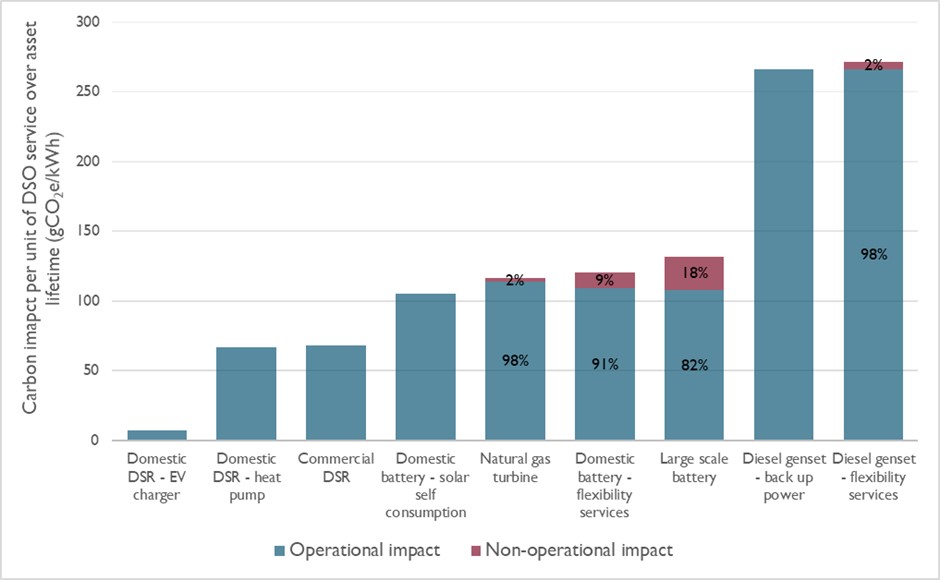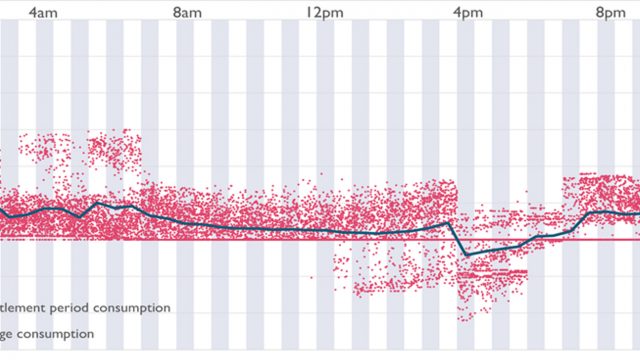Demand side response the lowest carbon form of flexibility
November 2020
Everoze has developed a carbon assessment methodology specifically aimed at DSO flexibility services. As part of the Pro Low Carbon project, this methodology has been applied to calculate and rank the carbon impacts of a range of local flexibility technologies. Everoze partner Benjamin Lock describes why the results might not be quite what you were expecting.
But first, let me talk about how we got to them. Everoze has been working alongside Western Power Distribution on the innovation project Future Flex, which strives to increase the uptake of domestic flexibility solutions in the provision of DSO services. Back in the heady, mask-free days of early 2020 we ran a series of workshops with domestic flex industry players. The idea was to sound out all the barriers they were facing in their work. One resounding bit of feedback was about carbon. Specifically: that the low carbon nature of their technologies was not being rewarded.
We took this onboard and, as any consultant worth their buzzwords will tell you, “you can’t manage what you can’t measure”. Pro Low Carbon is about exactly that: measuring the carbon impact of procuring DSO services from flexibility services.
We designed a consequential carbon assessment methodology that includes impacts from manufacturing, disposal and operations. We then applied this methodology to a range of local flexibility technologies. The complete set of findings is available here.
So what did we find out?
Smart EV charging has the lowest carbon impact.
The top third of the rankings are dominated by DSR, with smart EV charging sitting at the very top. This means that EVs are the lowest carbon form of flexibility available to DSOs. The superiority of all DSR technologies can be put down to low losses (none at all for EV charging) and the fact that no embodied emissions are assigned to DSR – our methodology does not include manufacturing or disposal impacts for technologies that are primarily used for another purpose (people buy EV chargers to charge cars, not provide DSO services).
Battery projects are mid-pack and on a par with natural gas turbines (for now).
Battery projects, both domestic and large scale, sit midway in the technology hierarchy. The biggest factor driving this result is the round-trip losses. More energy goes into a battery than comes out, so unless what’s imported is much lower carbon than the generation that is displaced when the battery exports, the storage of energy leads to an increase in carbon emissions. The good news is that as the marginal carbon intensity of the grid decreases over time, the carbon impact of batteries will improve.
The same can’t be said for natural gas turbines. Nevertheless, with today’s numbers their carbon impact of DSO service provision is on a par with batteries. And gas turbines do have things going for them – particularly their long lifetimes and relatively low embodied carbon. But as time passes their carbon impacts will worsen: the marginal generator that these turbines offset when they pump out electricity will get cleaner, but the direct emissions of the gas turbine – the combustion of the gas itself – will remain just as polluting as ever. 
Where do we go from here?
Carbon in flexibility markets is a hot topic right now. BEIS and Ofgem are consulting on the next phase of their Smart Systems and Flexibility Plan with carbon in flexibility markets a key focus area. And Ofgem’s new RIIO-2 price control framework puts a strong (although maybe not strong enough) focus on carbon reduction at the distribution network level.
Sharing these results brings the Pro Low Carbon project to an end. But looking forward, we’re thinking about how to apply what we have learnt to achieve tangible, real-world impacts.
For a start, going back to my consultant-speak catchphrase from earlier, we know that we need to measure the carbon impacts of flex markets providers. So why not make steps to embed carbon data transparency in flexibility markets, reporting on impacts across DSO services and even national level markets and making sure that the data is there on which to act.
Once the data is clear for all to see, we can start to act on it. A starting point could be to explore how data signals can help flexibility market participants reduce their carbon impact. Our work to date assumes that assets operate in way that maximises profits, not minimises carbon. But if asset operators understood the carbon impacts of their decisions, they would be better placed to reduce them.
However, some might require incentives that are a little more forceful. The culmination of this work would be the development and national-level implementation of measures to reduce the carbon impacts of flexibility procurement. This could permit any number of mechanisms, including preferential treatment of low carbon providers in DSO service procurement (something which is currently prohibited). Whatever it is, it needs to be comprehensive, fair, and loophole free.
We’re looking forward to helping make this happen. Do you have ideas on how to further the cause? We’d love to hear them






